Enema
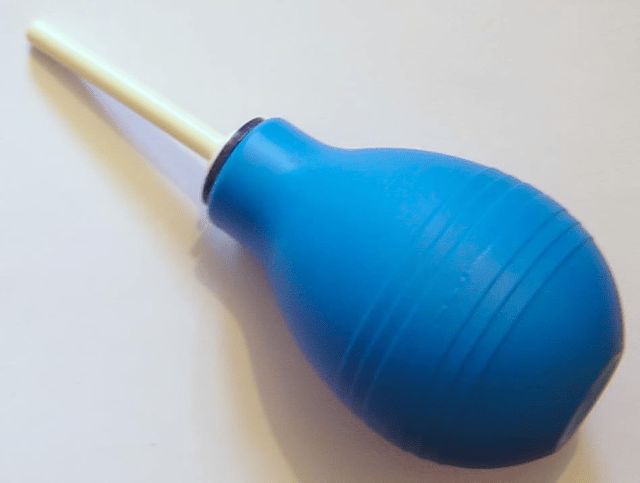
Enema

| Enema | |
|---|---|
| Pronunciation | |
| Other names | Clyster |
In standard medicine, the most frequent uses of enemas are to relieve constipation and for bowel cleansing before a medical examination or procedure;[5] also, they are employed as a lower gastrointestinal series (also called a barium enema),[6] to check diarrhea,[7] as a vehicle for the administration of food, water or medicine, as a stimulant to the general system, as a local application and, more rarely, as a means of reducing temperature,[1] as treatment for encopresis, and as a form of rehydration therapy (proctoclysis) in patients for whom intravenous therapy is not applicable.[8]
In other contexts, enemas are used by some alternative health therapies, used for enjoyment, chiefly as part of sexual activities, but also in sadomasochism, as well as simply for pleasure, used to intoxicate with alcohol, used to administer drugs for both recreational and religious reasons, and used for punishment.
| Enema | |
|---|---|
| Pronunciation | |
| Other names | Clyster |
Medical usage
The principal medical usages of enemas are:
Bowel cleansing
Acute treatments
As bowel stimulants, enemas are employed for the same purposes as orally administered laxatives: To relieve constipation; To treat fecal impaction; To empty the colon prior to a medical procedure such as a colonoscopy. A large volume of enema[9] can be given to cleanse as much of the colon as possible of feces.[10][11] However, a low enema is generally useful only for stool in the rectum, not in the intestinal tract.[12]
Such enemas' mechanism consists of the volume of the liquid causing rapid expansion of the intestinal tract in conjunction with, in the case of certain solutions, irritation of the intestinal mucosa, resulting in powerful peristalsis and a feeling of extreme fecal urgency. The enema is retained until there is a tremendous, uncontrollable urge to defecate, at which time the recipient may expel any fecal matter loosened by the instilled solution together with the solution itself.
The procedure may cause uncomfortable bloating and cramping.[13]
Large volume enemas
Plain water can be used, simply functioning mechanically to expand the colon, thus prompting evacuation.
Normal saline is least irritating to the colon, at the opposite end of the spectrum. Like plain water, it simply functions mechanically to expand the colon, but having a neutral concentration gradient, it neither draws electrolytes from the body, as happens with plain water, nor draws water into the colon, as occurs with phosphates. Thus, a salt water solution can be used when a longer period of retention is desired, such as to soften an impaction.
Equal parts of milk and molasses heated together to slightly above normal body temperature have been used.[17] Neither the milk sugars and proteins nor the molasses are absorbed in the lower intestine, thus keeping the water from the enema in the intestine.[18] Studies have shown that milk and molasses enemas have a low complication rate when used in the emergency department[19] and are safe and effective with minimal side effects.[20]
Mineral oil functions as a lubricant and stool softener, but may have side effects including rectal skin irritation and leakage of oil[21] which can soil undergarments for up to 24 hours.
Micro-enemas
In alphabetical order
Arachis oil (peanut oil) enema is useful for softening stools which are impacted higher than the rectum.[22]
Glycerol has a hyperosmotic effect and can be used as a small-volume (2–10 ml) enema (or suppository).[15]
Mineral oil is used as a lubricant because most of the ingested material is excreted in the stool rather than being absorbed by the body.[30]
Sodium phosphate.[31][32] Also known by the brand name Fleet. Available at drugstores; usually self-administered. Buffered sodium phosphate solution draws additional water from the bloodstream into the colon to increase the effectiveness of the enema. But it can be rather irritating to the colon, causing intense cramping or "griping." Fleet enemas usually causes a bowel movement in 1 to 5 minutes. Known adverse effects.
Sorbitol pulls water into the large intestines causing distention, thereby stimulating the normal forward movement of the bowels. Sorbitol is found in some dried fruits and may contribute to the laxative effects of prunes.[33] and is available for taking orally as a laxative.[34][35] As an enema for constipation, the recommended adult dose is 120 mL of 25-30% solution, administered once.[36] Note that Sorbitol is an ingredient of the MICROLAX® Enema.
In alphabetical order of the original brand names
Klyx contains docusate sodium 1 mg/mL and sorbitol solution (70%) (crystallising) 357 mg/mL and is used for faecal impaction or constipation or for colon evacuation prior medical procedures,[37] developed by Ferring B.V..
Micralax (not to be confused with MICROLAX®)[38]
MICROLAX® (not to be confused with Micralax) combines the action of sodium citrate, a peptidising agent which can displace bound water present in the faeces, with sodium alkyl sulphoacetate, a wetting agent, and with glycerol, an anal mucosa irritant and hyperosmotic. However, also sold under the name "Micralax", is a preparation containing sorbitol rather than glycerol;[39] which was initially tested in preparation for sigmoidoscopy.[40]
Chronic treatments
Transanal irrigation
TAI, also termed retrograde irrigation, is designed to assist evacuation using a water enema[42] as a treatment for persons with bowel dysfunction, including fecal incontinence or constipation, especially obstructed defecation. By regularly emptying the bowel using transanal irrigation,[43] controlled bowel function is often re-established to a high degree, thus enabling development of a consistent bowel routine.[43] Its effectiveness varies considerably, some individuals experiencing complete control of incontinence but others reporting little or no benefit.[42]
An international consensus on when and how to use transanal irrigation for people with bowel problems was published in 2013, offering practitioners a clear, comprehensive and simple guide to practice for the emerging therapeutic area of transanal irrigation.[43]
The term retrograde irrigation distinguishes this procedure from the Malone antegrade continence enema, where irrigation fluid is introduced into the colon proximal to the anus via a surgically created irrigation port.
Bowel management
Patients who have a bowel disability, a medical condition which impairs control of defecation, e.g., fecal incontinence or constipation,[44] can use bowel management techniques to choose a predictable time and place to evacuate.[44] Without bowel management, such persons might either suffer from the feeling of not getting relief, or they might soil themselves.[44]
Contrast (X-ray)
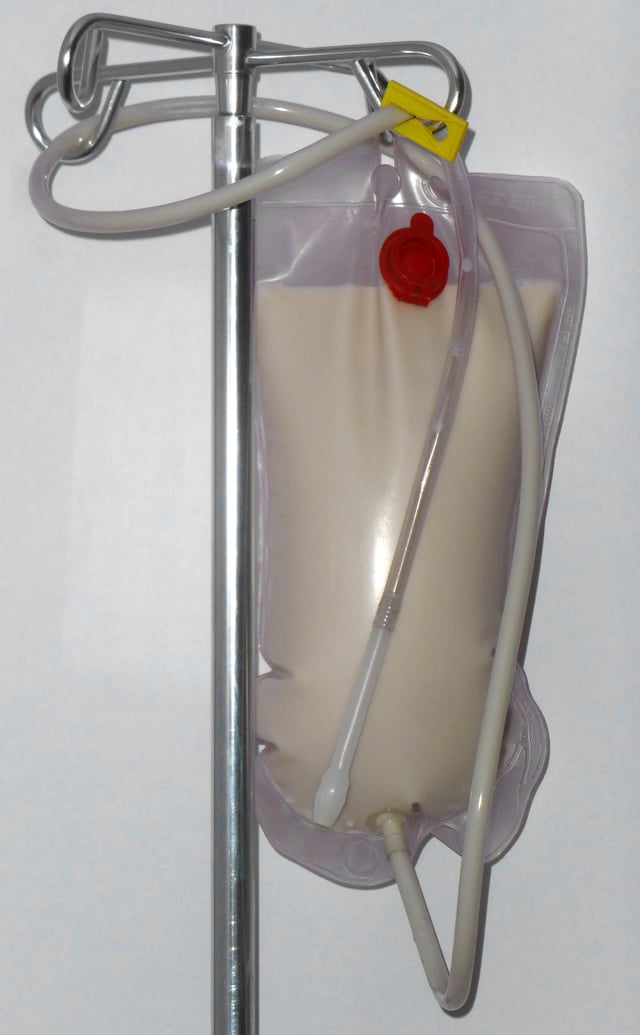
A barium enema in a disposable bag manufactured for that purpose
In a lower gastrointestinal series an enema that may contain barium sulfate powder or a water-soluble contrast agent is used in the radiological imaging of the bowel. Called a barium enema, such enemas are sometimes the only practical way to view the colon in a relatively safe manner.[6]
Medication administration
The administration of substances into the bloodstream.
This may be done in situations where it is undesirable or impossible to deliver a medication by mouth, such as antiemetics given to reduce nausea (though not many antiemetics are delivered by enema). Additionally, several anti-angiogenic agents, which work better without digestion, can be safely administered via a gentle enema.
The topical administration of medications into the rectum, such as corticosteroids and mesalazine used in the treatment of inflammatory bowel disease. Administration by enema avoids having the medication pass through the entire gastrointestinal tract, therefore simplifying the delivery of the medication to the affected area and limiting the amount that is absorbed into the bloodstream.
Rectal corticosteroid enemas are sometimes used to treat mild or moderate ulcerative colitis.
They also may be used along with systemic (oral or injection) corticosteroids or other medicines to treat severe disease or mild to moderate disease that has spread too far to be treated effectively by medicine inserted into the rectum alone.
Inhibiting pathological defecation
Traveller's diarrhea’s symptoms treated with an enema of sodium butyrate, organic acids, and A-300 silicon dioxide can be successfully decreased with lack of observed side effects.[7]
Shigellosis treatment benefits from adjunct therapy with butyrate enemas, promoting healing of the rectal mucosa and inflammation, but not helping in clinical recovery from shigellosis. Use of an 80 ml of a sodium butyrate isotonic enema administered every 12 hours has been studied and found effective.[48]
Other
There have been a few cases in remote or rural settings, where rectal fluids have been used to rehydrate a person.
Benefits include not needing to use sterile fluids.[49]
Introducing healthy bacterial flora through infusion of stool, known as a fecal microbiota transplant, was first performed in 1958 employing retention enemas. Enemas remained the most common method until 1989, when alternative means of administration were developed.[50] As of 2013, colonoscope implantation has been preferred over fecal enemas because by using the former method, the entire colon and ileum can be inoculated, but enemas reach only to the splenic flexure.[51]
A patient unable to be fed otherwise can be nourished by an enteral administration of predigested foods, which is known as a nutrient enema. [52] This treatment is ancient, dating back at least to the second century CE when documented by Galen,[53] and commonly used in the Middle Ages,[54] remaining a common technique in 19th century,[55] and as recently as 1941 the U. S.' military manual for hospital diets prescribes their use.[56] Nutrient enemas have been superseded in modern medical care by tube feeding and intravenous feeding.
Enemas have been used around the time of childbirth however there is no evidence for this practice and it is now discouraged.[57]
Adverse effects
Improper administration of an enema can cause electrolyte imbalance (with repeated enemas) or ruptures to the bowel or rectal tissues resulting in internal bleeding. However, these occurrences are rare in healthy, sober adults. Internal bleeding or rupture may leave the individual exposed to infections from intestinal bacteria. Blood resulting from tears in the colon may not always be visible, but can be distinguished if the feces are unusually dark or have a red hue. If intestinal rupture is suspected, medical assistance should be obtained immediately.[58]
The enema tube and solution may stimulate the vagus nerve, which may trigger an arrhythmia such as bradycardia.
Enemas should not be used if there is an undiagnosed abdominal pain since the peristalsis of the bowel can cause an inflamed appendix to rupture.
There are arguments both for and against colonic irrigation in people with diverticulitis, ulcerative colitis, Crohn's disease, severe or internal hemorrhoids or tumors in the rectum or colon, and its usage is not recommended soon after bowel surgery (unless directed by one's health care provider). Regular treatments should be avoided by people with heart disease or renal failure. Colonics are inappropriate for people with bowel, rectal or anal pathologies where the pathology contributes to the risk of bowel perforation.[59]
Recent research has shown that ozone water, which is sometimes used in enemas, can immediately cause microscopic colitis.[60]
A recent case series[61] of 11 patients with five deaths illustrated the danger of phosphate enemas in high-risk patients.
History
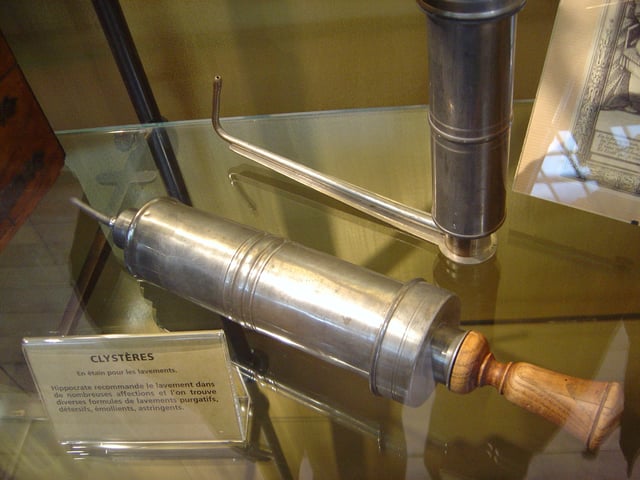
A normal clyster syringe (front) and the nozzle for a syringe designed for self-administration * (rear)*. The latter avoided the need for a second party to attend an embarrassing procedure.
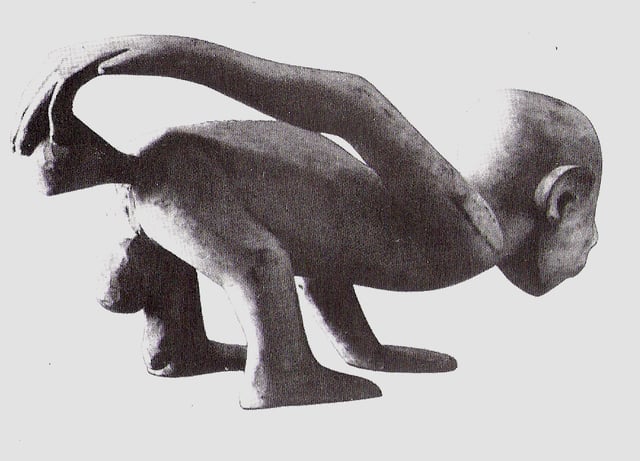
Pressure enema from an animal bladder (African wooden sculpture, 19th century)
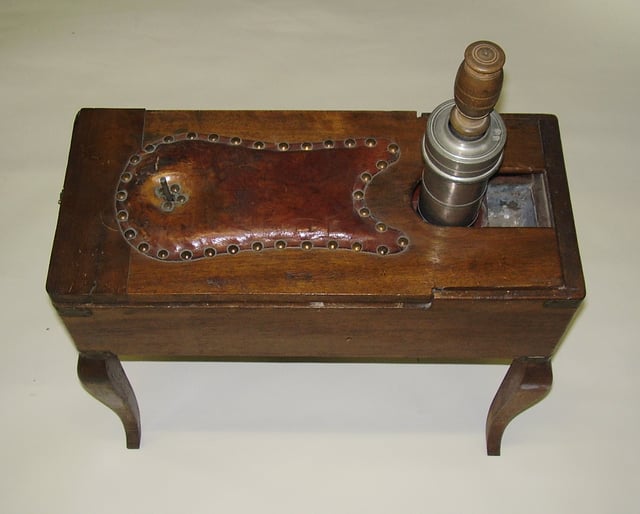
Portable enema self-administration apparatus by Giovanni Alessandro Brambilla (18th century; Medical History Museum, University of Zurich)
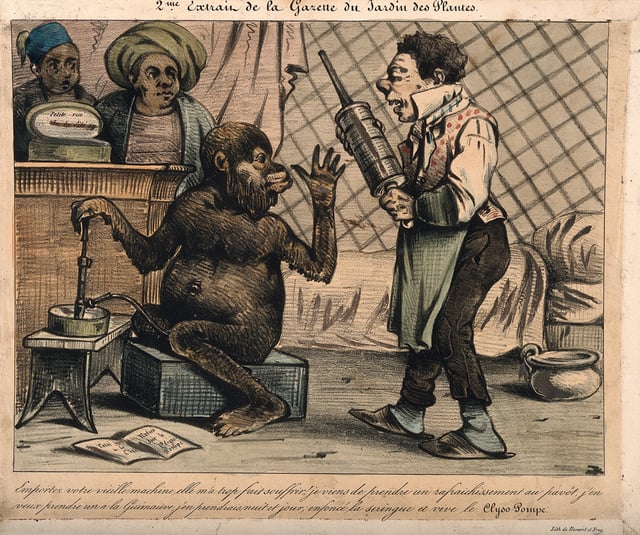
19th century satirical cartoon of a monkey rejecting an old style clyster for a new design, filled with marshmallow and opium
Clyster (/ˈklɪstə(r)/) entered the English Language in the late 14th century via Old French clistre or Latin clyster, from Greek κλυστήρ, "syringe". Also spelled glister in the 17th century, rarely cloiste" or clister, it is an archaic word for enema, more particularly for enemas administered using a clyster syringe – that is, a syringe with a rectal nozzle and a plunger rather than a bulb. Clyster syringes were used from the 17th century (or before) to the 19th century, when they were largely replaced by enema bulb syringes, bocks, and bags.
The first mention of the enema in medical literature is in the Ancient Egyptian Ebers Papyrus (c. 1550 BCE). One of the many types of medical specialists was an Iri, the Shepherd of the Anus. Many medications were administered by enemas.[63] There was a Keeper of the Royal Rectum who may have primarily been the pharaoh's enema maker. The god Thoth, according to Egyptian mythology, invented the enema.[64]
The Olmec from their middle preclassic period (10th through 7th centuries BCE) through the Spanish Conquest used trance-inducing substances ceremonially, and these were ingested via, among other routes, enemas administered using jars.
As further described below in religious rituals, the Maya in their late classic age (7th through 10th centuries CE) used enemas for, at least, ritual purposes, Mayan sculpture and ceramics from that period depicting scenes in which, injected by syringes made of gourd and clay, ritual hallucinogenic enemas were taken.[65] In the Xibalban court of the God D, whose worship included ritual cult paraphernal, the Maya illustrated the use of a characteristic enema bulb syringe by female attendants administering clysters ritually.[66][67]
For combating illness and discomfort of the digestive tract, the Mayan also employed enemas, as documented during the colonial period, e.g., in the Florentine Codex.[65]
A rubber bag connected with a conical nozzle, at an early period, was in use among the indigenous peoples of South America as an enema syringe,[70] and the rubber enema bag with a connecting tube and ivory tip remained in use by them while in Europe a syringe was still the usual means for conducting an enema.[71]
In Babylonia, by 600 BCE, enemas were in use, although it appears that initially they were in use because of a belief that the demon of disease would, by means of an enema, be driven out of the body.[72]
In China, c. 200 CE, Zhang Zhongjing was the first to employ enemas. "Secure a large pig's bile and mix with a small quantity of vinegar. Insert a bamboo tube three or four inches long into the rectum and inject the mixture" are his directions, according to Wu Lien-teh.[73]
In India, in the fifth century CE, Sushruta enumerates the enema syringe among 121 surgical instruments described. Early Indian physicians' enema apparatus consisted of a tube of bamboo, ivory, or horn attached to the scrotum of a deer, goat, or ox.[72]
Hippocrates (460-370 BCE) frequently mentions enemas, e.g., "if the previous food which the patient has recently eaten should not have gone down, give an enema if the patient be strong and in the prime of life, but if he be weak, a suppository should be administered, should the bowels be not well moved on their own accord."[74]
In the first century BCE the Greek physician Asclepiades of Bithynia wrote "Treatment consists merely of three elements: drink, food, and the enema".[75] Also, he contended that indigestion is caused by particles of food that are too big and his prescribed treatment was proper amounts of food and wine followed by an enema which would remove the improper food doing the damage.[75]
In medieval times appear the first illustrations of enema equipment in the Western world, a clyster syringe consisting of a tube attached to a pump action bulb made of a pig bladder. In the 15th century simple piston syringe clysters came into use. Beginning in the 17th century enema apparatus was chiefly designed for self-administration at home and many were French as enemas enjoyed wide usage in France.[77]
When clyster syringes were in use in Europe, the patient was placed in an appropriate position (kneeling, with the buttocks raised, or lying on the side); a servant or apothecary would then insert the nozzle into the anus and press the plunger, resulting in the liquid remedy (generally, water, but also some other preparations) being injected into the colon.
Because of the embarrassment a woman might feel when showing her buttocks (and possibly her genitals, depending on the position) to a male apothecary, some contraptions were invented that blocked all from the apothecary's view except for the anal area.
Another invention was syringes equipped with a special bent nozzle, which enabled self-administration, thereby eliminating the embarrassment.
Clysters were administered for symptoms of constipation and, with more questionable effectiveness, stomach aches and other illnesses.
In 1694 François Mauriceau in his early-modern treatise, The Diseases of Women with Child, records that both midwives and man-midwives commonly administered clysters to labouring mothers just prior to their delivery.[78]
In the 17th century, satirists made physicians a favorite target, resembling Molière's caricature whose prescription for anything was "clyster, bleed, purge," or "purge, bleed, clyster.",[79] e.g., in his 1673 play The Imaginary Invalid.[80] Sir Thomas More's eldest daughter had fallen sick of the sweating sickness and could not be awakened by doctors. More prayed for her recovery, and then
where incontinent came into his mind, that a glister should be the only way to help her, which when he had told the physicians, they by-and-by confessed, that if there were any hope of health, that it was the very best help indeed, much marvelling of themselves, that they had not afore remembered it.[81]
In 1753 an enema bag prepared from a pig's or beef's bladder attached to a tube was described by Johann Jacob Woyts as an alternative to a syringe.[82]
In the 18th century Europeans began emulating the indigenous peoples of North America's use of tobacco smoke enemas to resuscitate drowned people.[83] Tobacco resuscitation kits consisting of a pair of bellows and a tube were provided by the Royal Humane Society of London and placed at various points along the Thames.[77] Furthermore, these enemas came to be employed for headaches, respiratory failure, colds, hernias, abdominal cramps, typhoid fever, and cholera outbreaks.[83]
Clysters were a favourite medical treatment in the bourgeoisie and nobility of the Western world up to the 19th century. As medical knowledge was fairly limited at the time, purgative clysters were used for a wide variety of ailments, the foremost of which were stomach aches and constipation.
Molière, in several of his plays, introduces characters of incompetent physicians and apothecaries fond of prescribing this remedy, also discussed by Argan, the hypochondriac patient of Le Malade Imaginaire. More generally, clysters were a theme in the burlesque comedies of that time.
According to Claude de Rouvroy, duc de Saint-Simon, clysters were so popular at the court of King Louis XIV of France that the duchess of Burgundy had her servant give her a clyster in front of the King (her modesty being preserved by an adequate posture) before going to the comedy. However, he also mentions the astonishment of the King and Mme de Maintenon that she should take it before them.
In the 19th century many new types of enema administration equipment were devised, including the bulb enema.
Later there came to be a device to allow gravity to infuse the solution into the recipient, consisting of a rubber bag or bucket connected to a hose with a nozzle at the other end to insert into the patient's anus, the bag or bucket being held or hung above the patient.
These continue to be used, although rubber has been replaced by modern materials and the bags, at least in hospital use, are disposable.[77]
In the late 20th century the microenema was invented, this being a disposable squeeze bottle with contents that cause the body to draw water into the colon, e.g., sodium biphosphate (popular in the United States) or glycerin (popular in Japan).
Society and culture
Alternative medicine
Benign
Colonic irrigation
The term "colonic irrigation" is commonly used in gastroenterology to refer to the practice of introducing water through a colostomy or a surgically constructed conduit as a treatment for constipation.[84] The Food and Drug Administration has ruled that colonic irrigation equipment is not approved for sale for the purpose of general well-being[85] and has taken action against many distributors of this equipment, including a Warning Letter.[86]
Colon cleansing
The same term is also used in alternative medicine where it may involve the use of substances mixed with water in order to detoxify the body. Practitioners believe the accumulation of fecal matter in the large intestine leads to ill health.[87] This resurrects the old medical concept of autointoxication which was orthodox doctrine up to the end of the 19th century but which has now been discredited.[88][89][90]
Kellogg's enemas
In the late 19th century Dr. John Harvey Kellogg made sure that the bowel of each and every patient was plied with water, from above and below. His favorite device was an enema machine ("just like one I saw in Germany") that could run fifteen gallons of water through a person's bowel in a matter of seconds. Every water enema was followed by a pint of yogurt—half was eaten, the other half was administered by enema "thus planting the protective germs where they are most needed and may render most effective service." The yogurt served to replace "the intestinal flora" of the bowel, creating what Kellogg claimed was a completely clean intestine.[91]
Dangerous
Bleach enemas
Chlorine dioxide enemas have been fraudulently marketed as a medical treatment, primarily for autism. This has resulted, for example, in a six-year-old boy needing to have his bowel removed and a colostomy bag fitted,[92][93] complaints to the FDA reporting life-threatening reactions,[94] and even death.[95]
Patently false claims that administering autistic children these enemas results in their expulsion of parasites ("rope worms"), which actually are the intestinal lining and membranes.[96][97] These enemas have also been promoted as a cure for HIV, malaria, hepatitis viruses, the H1N1 flu virus, common colds, acne, cancer, Parkinson's, and much more.
Chlorine dioxide is a potent and toxic bleach[98] that is relabeled for "medicinal" purposes to a variety of brand names including, but not limited, to MMS, Miracle Mineral Supplement, and CD protocol.[99] For oral use, the doses recommended on the labeling can cause nausea, vomiting, diarrhea, severe dehydration, and other life-threatening conditions.[100]
No clinical trials have been performed to test these enemas' claims, which come only from former Scientologist Jim Humble [101] in his 2006 self-published book, The Miracle Mineral Solution of the 21st Century [102] and from anecdotal reports. The name MMS was coined by Humble. Sellers sometimes describe MMS as a water purifier so as to circumvent medical regulations.[103] The International Federation of Red Cross and Red Crescent Societies rejected "in the strongest terms" reports by promoters of MMS that they had used the product to fight malaria.[104]
Coffee enemas
Although well documented, the procedure of inserting coffee through the anus to cleanse the rectum and large intestines is considered by most medical authorities to be unproven, rash and potentially dangerous.[[105]](https://portal.issn.org/resource/ISSN/"Colonic irrigation and the theory of autointoxication: a triumph of ignorance over science")[106]
Coffee enemas can cause numerous side effects, including infections, sepsis (including campylobacter sepsis), severe electrolyte imbalance, colitis, polymicrobial enteric sepsis, proctocolitis, salmonella, brain abscess, and heart failure,[107][108][109][110][111][112][113][114][111] and deaths related to coffee enemas have been documented.[110]
In the Gerson therapy, coffee enemas are administered.[117]
Recreational usage
Pleasure
Klismaphiles can gain satisfaction of enemas through fantasies, by actually receiving or giving one, or through the process of eliminating steps to being administered one (e.g., under the pretence of being constipated).[121] An enema can be an auxiliary to, or even a substitute for, genital sexual activity.[122][121]
That some women use enemas while masturbating was documented by Kinsey, A. in "Sexual Behavior in the Human Female." He stated, "There still [are] other masturbatory techniques which were regularly or occasionally employed by some 11 percent of the females in the sample... enemas, and other anal insertions,... were employed."[123]
Enemas are sometimes used in sadomasochistic activities[124]*Different%20loving%20%E2%80%93%20The%20World%20of%20Sex]]*Different%20loving%20%E2%80%93%20The%20World%20of%20Sex]]*Different%20loving%20%E2%80%93%20The%20World%20of%20Sex]]Different%20loving%20%E2%80%93%20The%20World%20of%20Sex]]
Intoxication
Noting that deaths have been reported from alcohol poisoning via enemas,[129] an alcohol enema can be used to very quickly instill alcohol into the bloodstream, absorbed through the membranes of the colon. However, great care must be taken as to the amount of alcohol used. Only a small amount is needed as the intestine absorbs the alcohol far more quickly than the stomach.
Preceding an enema for administration of drugs or alcohol, a cleansing enema may first be used for cleaning the colon to help increase the rate of absorption.[130]
Religious rituals
All across Mesoamerica ritual enemas were employed to consume psychoactive substances, e.g., balché, alcohol, tobacco, peyote, and other hallucinogenic drugs and entheogens, most notably by the Maya, thus attaining more intense trance states more quickly, and Mayan classic-period sculpture and ceramics depict hallucinogenic enemas used in rituals.[65] Some tribes continue the practice in the present day.[131]
With historical roots in the Indian subcontinent, enemas in Ayurveda, called Basti or Vasti, form part of Panchakarma procedure in which herbal medicines are introduced rectally.[132]
Punitive usage
Enemas have also been forcibly applied as a means of punishment.
In the vastly influential Argentine text Facundo, or Civilization and Barbarism, for example, Domingo Faustino Sarmiento describes the use of pepper and turpentine enemas by police forces as a way of discouraging political dissent in post-independence Argentina.[133] Turpentine enemas are very harsh purgatives.[134]
In the Guantanamo Bay Detention Camp, the Senate Intelligence Committee report on CIA torture documented instances of enemas being used by the Central Intelligence Agency in order to ensure "total control" over detainees.[135] Enemas, officials said, are uncomfortable and degrading,[136] The CIA forced nutrient enema on detainees who attempted hunger strikes, documenting “With head lower than torso … sloshing up the large intestines … [what] I infer is that you get a tube up as you can … We used the largest Ewal [sic] tube we had” wrote an officer,[137] and "violent enemas" is how a detainee described what he received.[138]
In arts and literature
Written literature
In Shakespeare's play Othello (Act II, Scene I) Iago says, "Yet again your fingers to your lips? would they were clyster-pipes for your sake!"[139]
In George Orwell's novel Nineteen Eighty-Four, the narrator notes, "Sexual intercourse was to be looked on as a slightly disgusting minor operation, like having an enema."[140]
In Flora Rheta Schreiber's book Sybil, Sybil's psychiatrist asks her “What’s Mama been doing to you, dear?... I know she gave you the enemas."[143]
In Anne Roiphe's novel Torch Song, Marjorie, not knowing how to otherwise address her dysphonia, reminisces on unhappy memories, one of which is her German nurse inflicting on her painful enemas.[144]
In Anne Sexton's poem "Cripples And Other Stories", is the couplet "Oh the enemas of childhood, reeking of outhouses and shame!"[145]
Film
In Sybil, Sybil's psychiatrist, while having taken her for a picnic in the country, heard her re-experience, among other things, her mother having bound her with a broom handle on the kitchen table and suspended her by her feet from the hanging light, in preparation for forcing her to take an enema.[149]
Song
The lyrics of Frank Zappa's song The Illinois Enema Bandit are concerned with Michael H. Kenyon's sexual assaults which included administering involuntary enemas[150]
Monument
A 365-kilogram (805-pound) brass statue of a syringe enema bulb held aloft by three cherubs stands in front of the "Mashuk" spa in the settlement of Zheleznovodsk in Russia. Inspired by the 15th century Renaissance painter Botticelli, it was created by a local artist who commented that "Aa enema is an unpleasant procedure as many of us may know. But when cherubs do it, it's all right." When unveiled on 19 June 2008, posted on one of the spa's wall was a banner declaring "Let's beat constipation and sloppiness with enemas." The spa lying in the Caucasus Mountains region, known for dozens of spas that routinely treat digestive and other complaints with enemas of mineral spring water, the director commented "An enema is almost a symbol of our region." [151][152] It is the only known monument to the enema.[153]
See also
Alcohol enema
Bowel management
Coffee enema
Colon cleansing
Klismaphilia
Rectal douching
Transanal irrigation